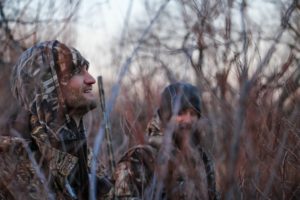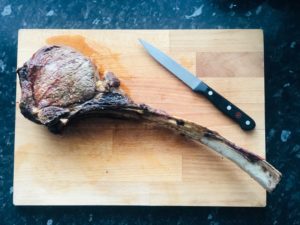Hunting season is here. Avid hunters are usually well-versed in gun safety, but in order to avoid foodborne illness, it is vital to discuss the importance of field dressing.

What are the dangers of field dressing wild game?
If not done properly, field dressing, transporting, and handling animals (mammals, fish, and birds) can introduce harmful bacteria such as Salmonella and E. coli. In addition, wild game contains microscopic pathogens that can cross-contaminate every tool and surface that they touch.
In addition to taking care when handling, dressing, and transporting wild game, hunters should be mindful of temperature. Improper temperature control can allow pathogens to grow, causing serious health risks if the game is consumed.
Field dressing safety tips
- Clean hands and surfaces with soap and water (preferably hot water).
- Pack towels, a plastic tarp, or drop cloth to use as a barrier between the ground and tools. This minimizes the risk for cross-contamination during field dressing.
- Carry disposable plastic gloves. Gloves are especially important if you have any open wounds on your hand. Even a tiny opening in your skin is enough to allow infection from pathogens and parasites.
- Carry pre-packaged alcohol wipes to wash your hands before, during, and after field dressing the animal.
- When the outdoor temperature is above 41 degrees Fahrenheit, bring coolers packed with ice. Packaged dry ice is a great option.
- When handling small animals, remove the hide as quickly as possible. It allows the carcass to cool quickly when surrounded by ice.
- Large game should have their hides removed quickly after harvest, especially if the outside temperature is above 41 degrees Fahrenheit. The longer the carcass sits out, the higher the chance that foodborne pathogens will grow to dangerous levels.
What not to do when hunting
Be mindful of Chronic Wasting Disease, or CWD, when hunting. Chronic wasting disease is an infectious prion disease that affects deer, elk, reindeer, sika deer, and moose. CWD is prevalent in North America. The Centers for Disease Control and Prevention (CDC) encourages hunters to consult with their state wildlife agencies to identify areas where CWD occurs. Check here to see CWD being tracked in Virginia.
Do not eat meat from deer and elk that look sick or test positive for CWD. Although there can be up to a two-year incubation period before symptoms appear, animals with this disease might appear underweight, weak, and disoriented. It is best to test the meat for CWD before consumption.
Do not wrap large game in plastic or a tarp. Wrapping the meat with a tarp to keep it “clean” during transport can be problematic because it traps heat which, in turn, keeps the animal’s internal temperature in the danger zone. If possible, pack the animal’s internal cavity with ice to cool it down.
Do not eat roadkill. Regardless of how long the animal has been on the road, the trauma of being hit by a vehicle can cause the rupture of internal organs. The sheer amount of bacteria that can result from gut spillage, a ruptured bladder, or torn intestines is not worth taking the chance.

Best practices for storing and preparing game
Chill the carcass rapidly, keep it cold, and cut up the carcass within seven days.
To get the most flavor, fresh venison can be frozen for up to eight months. Seasoned and cured venison can be frozen for up to four months.
Test wild game for CWD before consuming it. Because the incubation for CWD is up to two years, wild game might be contaminated even if the animal appeared to be healthy.
These tips, combined with gun and equipment safety measures, will allow for a safer hunting season. Happy hunting!
If you have suffered a foodborne illness due to the negligence of another, you may be entitled to compensation. Call Allen & Allen today for a free consultation, at 866-388-1307.






